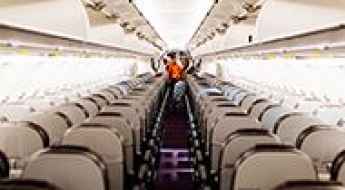Travel and tourism
NI's own Big Sur trumps landmarks
The Antrim Coast Road offers views more spectacular than the Grand Canyon in the US or Venezuela's Angel Falls, according to a survey. Sydney Opera House came top in the poll of 5,000 Britons by an Australian wine company to find places with the world's most spectacular views.
Top Places in the USA to Visit with Kids: A Comprehensive Guide for Unforgettable Family Adventures
Get ready to embark on a fun-filled journey with your kids to explore the best family-friendly destinations in the USA! And explore a selection of United States vacation rentals, including houses, apartment and condo rentals & more before your memorable trip with kids.
Plus Size Travel Destinations for Rest and Dating
Every person dreams of traveling the whole world. Yet, what most people don't realize is that traveling can be quite daunting and challenging for plus size folks. If you are a plus size, you most probably have wondered about the local attitudes of your intended destination. Will the steep hills or steps be too much for you? How fat-friendly will the transport be?
Fascinating and Breathtaking Abandoned Roads Around the Globe
Roads have been around since ancient times. They have been connecting civilizations to one another for long times and just like any other structures, they tend to deteriorate from time to time and when they get to a point when they are no longer repairable or usable, they are abandoned by usual traffic and travelers.
Get Ready for an Exciting Road Trip Across UAE With These Pro Tips
Embarking on a road trip across the United Arab Emirates (UAE) is a thrilling way to explore this diverse and captivating country. From the futuristic skylines of Dubai to the serene desert landscapes and historic towns, the UAE offers sights and experiences that can be best enjoyed by hitting the open road. However, a successful road trip requires careful planning and preparation. This article provides expert tips to ensure your UAE road trip is seamless and unforgettable.
5 Essential Road Travel Tips You Might Not Know
When you are getting ready for a road trip or just regular commuting travel on the road to and from work, it is important that you follow these tips so that you can always be prepared. Preparation doesn't mean the bad things won't happen or that you won't accidentally get a flat tire or get lost. Instead, preparation just means that when those events take place, you don't panic because you know what steps to follow, who to call, or what to do next.
How To Book Tickets For The Most Scenic Roads Online
There’s no better way to experience the world’s most scenic, exciting roads than by driving yourself. Winding around South Africa’s Garden Route or Australia’s Great Ocean Road, you experience all the exhilaration of gorgeous twists and turns. However, it is not always practical to drive yourself, especially in countries in which driving is a little more difficult. This is particularly true in many Asian countries, where you have to contend with countless bikes, liberal traffic rules, lanes which serve more as guidelines, and inconsiderate drivers.
The Most Dangerous Routes in Europe You Need to Take for the View
There is nothing like a road trip when it comes to traveling Europe. You can explore the marvelous sights, visit new places, and enjoy wonderful views. Whether you prefer mountains, valleys, or cities, there are lots to unpack.
2024 Travel Advisory: Country Risk Levels
The Canadian government has released its 2024 travel advisory, categorizing countries based on travel risk levels. These advisories help travelers understand potential dangers and make informed decisions before traveling.
The Best Road Trip in the World – According to Science
Have you ever wanted to travel cross-country? Do you think that it’s impossible to go on a road trip and see all the greatest landmarks in one go? Well, science will prove you wrong.
What Are the Best Roman Roads? Discover the Top Ancient Routes Across the Empire
It’s been more than a thousand years but Roman imperialism and glory can still be witnessed throughout Europe. Huge constructions and architecture made by the Romans are appreciated by the whole world. But the most impressive things that the Roman’s made is the network of roads.
8 Maps For Your Bug Out Bag
It's a true terror to lose your way while on a bug out. It’s a scenario for all to prepare for. Once you lose your path, you might run out of food and water. There’s no easy way to say this, but it will end badly.
Miami’s most notorious avenue
Krome Avenue may possibly be the most notorious road in South Florida. From haunting stories, to major crashes, this highway is quite dangerous and not for the faint of heart. While visiting Miami or South Florida, any dangerous road enthusiast would do well to take a ride along this road, especially at night for some people watching, as it is popular for young folks to drag race and generally ride along this area for star gazing, etc.
Europe's Most Dangerous Roads Every Adrenaline Junkie Should Visit
If you’re one of those people who actively seek out extreme and dangerous sports, taking this trip through the most dangerous roads in Europe will surely fill your palette. I could try to implore you to follow safety precautions. But if you’re the kind of person who gets their kicks by throwing caution to the wind, I can only wish you good luck.
5 Great Ways to Become a Travel Blogger
Who is a travel blogger? Would you like to become one? Most people cannot imagine travelling while blogging. But yes, it is possible to travel while blogging. There are many successful travel bloggers across the world. And this is enough proof that you can do it too if you want to.
Colorado Road Trip: Rocky Mountains, Denver, and Everything in Between
Set in the western US, Colorado features a diverse landscape with Rocky Mountains as its prime gem. But the scenic beauty of this state doesn’t stop there – there are other parks, lakes, charming gold rush towns, and the vibrant capital, Denver.
This Is How You Pack The Right Way For A Long Journey
Packing for a long journey can be both exciting and daunting. On one hand, it's a chance to explore new places and have new experiences. On the other hand, it requires careful planning and preparation to ensure that you have everything you need without carrying too much. In the text below, we’ll discuss the steps you can take to pack properly for a long journey.
Top Things To Do In Lenexa, KS in 2025
Lenexa, Kansas, is one of the fastest-growing cities in the Kansas City metro area, known for its community-driven atmosphere, scenic parks, and exciting events. Whether you're a local looking for new activities or a visitor exploring for the first time, this city offers plenty of opportunities for fun and relaxation. From cultural experiences to outdoor adventures, Lenexa has something for everyone.
5 Best Attractions in Odessa, TX You Shouldn't Miss
Odessa, TX, might not be the first city that comes to mind when planning a trip, but this West Texas gem has plenty of hidden treasures worth exploring. Whether you’re a history buff, an outdoor enthusiast, or someone who enjoys cultural experiences, Odessa has something for everyone. From unique historical sites to beautiful parks, there’s no shortage of attractions in Odessa, TX to keep you entertained.
Things to Do in Woodbridge, VA: Activities & Attractions
Woodbridge, VA, is often mentioned as a northern Virginia suburb conveniently located near Washington, D.C. Others best remember it as the home of Potomac Mills, a massive shopping mecca that draws visitors from all over. While these are certainly strong calling cards, Woodbridge is far more than just a convenient stopover or retail paradise.
Things to Do in Round Rock, TX
Round Rock—that's one city that’s buzzing with youthful energy, packed with entertainment hubs, and sprinkled with just enough history to keep things interesting. While nature enthusiasts might find limited green spaces here, boredom doesn’t stand a chance in Round Rock. The city’s many dynamic attractions more than make up for the limited lush greenery. Its proximity to Austin only amplifies the excitement, making Round Rock a must-visit destination. If you don’t already have it on your must-visit list, now is a good time to do so.
10 Best Things to Do in Chicago
Chicago, also known as the Windy City, is a vibrant metropolis known for its stunning architecture, deep dish pizza, and world-class museums. Whether you're visiting for the first time or you're a longtime resident, the city offers an endless list of activities that cater to every interest. From cultural attractions to thrilling outdoor experiences, there are countless things to do in Chicago that will leave you in awe. In this guide, we’ve compiled the top 10 things to do in Chicago that you simply can't miss.
Fun Things to Do in Austin, TX
Austin, Texas, is a city bursting with energy, creativity, and Southern charm. Whether you’re a new resident settling in or a visitor exploring its vibrant culture, the city offers endless opportunities for fun. From bat-watching under bridges to savoring world-class barbecue, Austin’s eclectic mix of activities ensures there’s something for everyone. Below, we’ve curated a list of must-try experiences.
Best Parks & Trails to Visit in Overland Park, KS
Overland Park, KS, is known for its scenic beauty, family-friendly atmosphere, and well-maintained green spaces. Whether you enjoy hiking, biking, or just a peaceful place to relax, this city offers some of the best parks in the Kansas City metro area.
The 7 Countries Most Dependent on Tourism
Tourism is a major global industry, accounting for a notable share of many countries’ gross domestic product (GDP). In some nations, tourism is a central pillar of the economy, supporting employment, infrastructure development, and service industries. Below is an overview of seven countries where tourism plays a particularly vital role in national economic activity.
6 Things To Do In Durham, NC
Durham, NC, is a lively city with endless opportunities for fun and relaxation. Located in the heart of the triangle area, it blends Southern charm with a modern twist that makes every weekend special. Here, you can enjoy the perfect mix of culture, history, and outdoor adventures that will leave you feeling refreshed and inspired.
Road Trip Guide: Mexico's Most Picturesque Coastal Drives
Planning a trip to Mexico is no easy feat, as there are plenty of things to think about in advance. From where you’ll be staying to how much you’ll be spending, there’s plenty to plan. Road trips are a great way to get a unique travel experience and do things your own way. Whether you prefer to check out the local scenery, historical sites, or food stands, road trips are the way to go.
How to Make Travel Videos for Your YouTube Channel
So you say you want to have a travel blog on YouTube, but you don’t know how travel videos are actually made? That’s not a big deal because you got here for a real treat: an easy, long-enough, and informational guide on how you make travel content on the biggest video-hosting platform in the world.
Exploring Sheikh Mohammed bin Zayed Road: The Most Notorious Highway in the UAE
The UAE is well-known for its well-maintained road infrastructure and commitment to safety. However, like in any country, certain routes provide additional difficulties and a larger risk factor. One such road is the E311, commonly known as the Sheikh Mohammed bin Zayed route.
Reasons for Students to Travel to Different Countries in Europe
We cannot deny the excitement of doing something different, whether trying out a new recipe, shopping for a new collection to add to your wardrobe, or even changing from one football club to another. It is a feeling like no other.
6 Tips for the Perfect Two-Person Car Trip
Memories from a successful car trip can stay with you for life. Traveling by car allows you to visit not only popular tourist destinations but also small, distinctive villages and lesser-known natural spots. The car gives you freedom of movement and helps you save money compared to relying on public transport, which can often be slow and expensive.
Miami Local Guide: Where to Go and What to Do
Miami is more than just sun-kissed beaches, Latin-inspired music, and world-class cuisine. This vibrant city offers a diverse blend of culture, art, history, and outdoor adventures, making it one of the most exciting destinations in the United States.
What Are the Best Packing Tips for a Road Trip? How to Maximize Luggage Space
A road trip is hands down the best way to get to know a region or country. You get to stop whenever you choose and take your time appreciating the sights that you see along the way. Of course, you also get to experience some of the most amazing roads in the world.
The Most Dangerous Roads in Asia
Since their appearance, roads have become an important part of civilization and have forever changed the way we live. Today, they have become a complex web of highways and country roads that connect countries and people. You might already have guessed that the busiest roads and most complicated connections are located in Asia.
10 Most Scenic Railroads Across France
One of the best ways to explore the true beauty of France is by hopping on a train and letting it take you through the most stunning locations! However, how to know which railways to choose and which journeys are the most worth it? Do not worry; we are here to help you make this decision. Here are our top 10 most scenic railroads across France!
What You’ll Need To Visit The Most Dangerous Roads
It takes a special kind of thrillseeker to want to visit the world’s most dangerous roads. These are some of the most treacherous, precarious environments on the planet, places where one wrong move could mean the difference between surviving and...well...not surviving. If you want to make a trip to one of these roads, then you have our congratulations; you’re almost certainly a more hardy and brave individual than we are.
Make Your Trip More Comfortable: 8 Simple Tips
Going on a trip is an exciting way to see new things, get new experiences, and meet people from different countries and cultures. However, while traveling can be highly enjoyable, to can also be very uncomfortable - especially during the time you spend on the road or in the sky.
4 Essential Travel Tips To Keep You Fresh On Long Road Trips
Men need the strongest holding hair wax, especially when going on long road trips to keep their hair perfect and unscathed. Moreover, heat can be a problem for keeping in style during long road trips since the release of sweat and oil in your hair makes it flat.
6 Things That Are Making Turkey A Popular Tourist Destination
If you’re an avid traveler or just looking to explore new cultures, Turkey is a great destination to consider. Whether you’re interested in history, architecture, food, or just relaxing on a beautiful beach, it has something for everyone.
How Students Can Travel While in College
College students are drowning in work the entire semester and need a break after some time. All the classes, assessments, homework assignments, and lectures can drain the life out of students. Travelling is an escape. Here are a few ways you can visit while you’re in college.
Best Countries for Trekking: 6 Trail-Rich Destinations
Hiking and trekking have a significant impact on both your body and mind, which cannot be underestimated. Apart from improving your overall fitness, these activities also help relieve stress, socialize with other people, and even develop your soft skills, such as organizing and time management.
Preparing for the Unexpected on a Road Trip
If you are heading out on a road trip on your own, with your partner, or with the family, you are in for a fun and exciting time. This is a great way to enjoy some adventure and exploration, and there are many wonderful areas and routes that you can choose for your road trip.
Comfortable Travelling for People with HGH Deficiency
Our hormones do amazing things — from helping us grow to regulating our mood, metabolism, and more. But when they become unbalanced, they can cause problems. For some, this happens during puberty or pregnancy. For others, it’s linked to a decline in human growth hormone (HGH).
Travel is the Best Education: How to Combine College with Travel
Traveling is the best education. It's an eye-opening experience, giving you a new perspective on life, creating new opportunities, and helping you to overcome fears or insecurities.
What Are the Essential Items to Pack for Any Trip? A Comprehensive Travel Preparation Guide
The modern information space is highly diversified. Any user can learn the basics of makeup, decoration, and cooking in a few clicks on the Internet. Travelling has also become a modern trend, and more and more people not only observe life in other places but also make independent trips. Most people love to travel. A trip to another city, country or just take a day tour to the mountains refreshes the mind and distracts from routine problems.
What are the essential items for female cyclists on a European tour?
Cycling Across Europe could easily be one of the best adventures of your life. Across all those cities and forest lands - you get a balanced view of glamour and greenery. There are so many tracks to choose from. You can do an easy 700 km or a tough 2000 km. It all depends on you.But, to make your tour really enjoyable, you must be well prepared. You should pack all the necessary things with you to make sure that nothing stops your trip short. At the same time, you must try to travel light.
7 Budget Travel Tips for Student Travelers
Travel offers the chance to explore new places, recharge after a busy routine, and gain new experiences. But for many students, limited budgets can make planning a trip feel overwhelming. Fortunately, with a bit of strategy and flexibility, it’s entirely possible to travel without overspending. Here are seven practical tips to help you explore the world while keeping your budget in check.
Why Biking Is the Best Choice for Students
As a student, you can’t spend your life without leaving your apartment or dorm. You have to move around a lot. You have classes to attend, appointments to go to, and extracurriculars to participate in. You probably frequent the library, too.
The 5 Most Romantic Bridges in the World
Bridges can be the perfect place to share a kiss. Whether it’s pouring rain or bright & sunny, there’s something about bridges that just makes them akin to romance. Perhaps it’s because they’re symbolic of a bond, or maybe it’s just the beautiful designs that go into creating them.
The worst roads for cyclists
2018 was the worst year to be a cyclist in the US according to the New York Times. At least two cyclists died on their bikes on roads across America daily, leading to over 700 deaths at the end of the year, the highest number since 1990.
Video editing on the road: a myth or reality?
With the advent of social media platforms, content creation has become the norm of the day. All kinds of blogs and vlogging have become extremely popular. Today, one in two people is a travel vlogger or a travel content creator. Therefore, travel vloggers and content creators of the new era face massive competition.
Useful International Languages Student Should Learn for Traveling Around the World
Language is what drives every progress made in the world. It is the foundation of all technology and innovation, politics, and culture. It is also essential when it comes to education. If you are a college student, you should know that there are certain languages to learn. This is especially important if you seek to travel out of the county.
The Most Romantic Bike Trips From Around the World: Roads That Can’t Be Forgotten
Road trips can be a great way to strengthen your relationship, but why not take a more personal approach? Taking a bicycle ride with your partner gives you more time to enjoy the views, exercise together, and open a new world of traveling possibilities!
What Are the Must-Have Travel Essentials for Men? A Complete Packing Guide
Travelling requires prior planning and getting and packing your essentials is one part of planning. When packing your essentials your eyes need to be focused on your destination and the journey leading to it.





















































